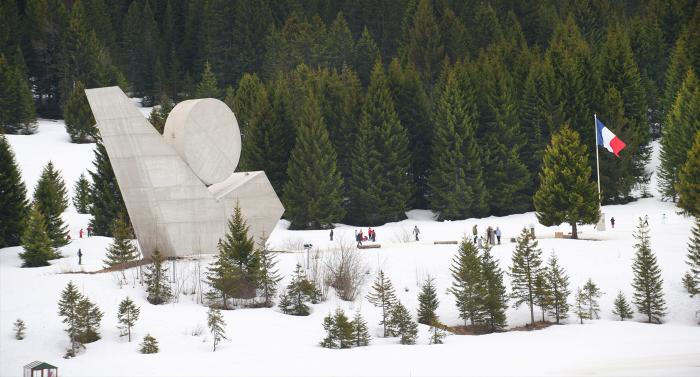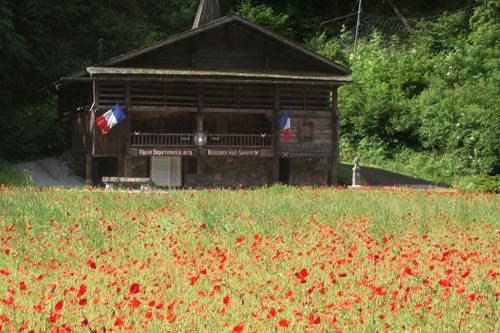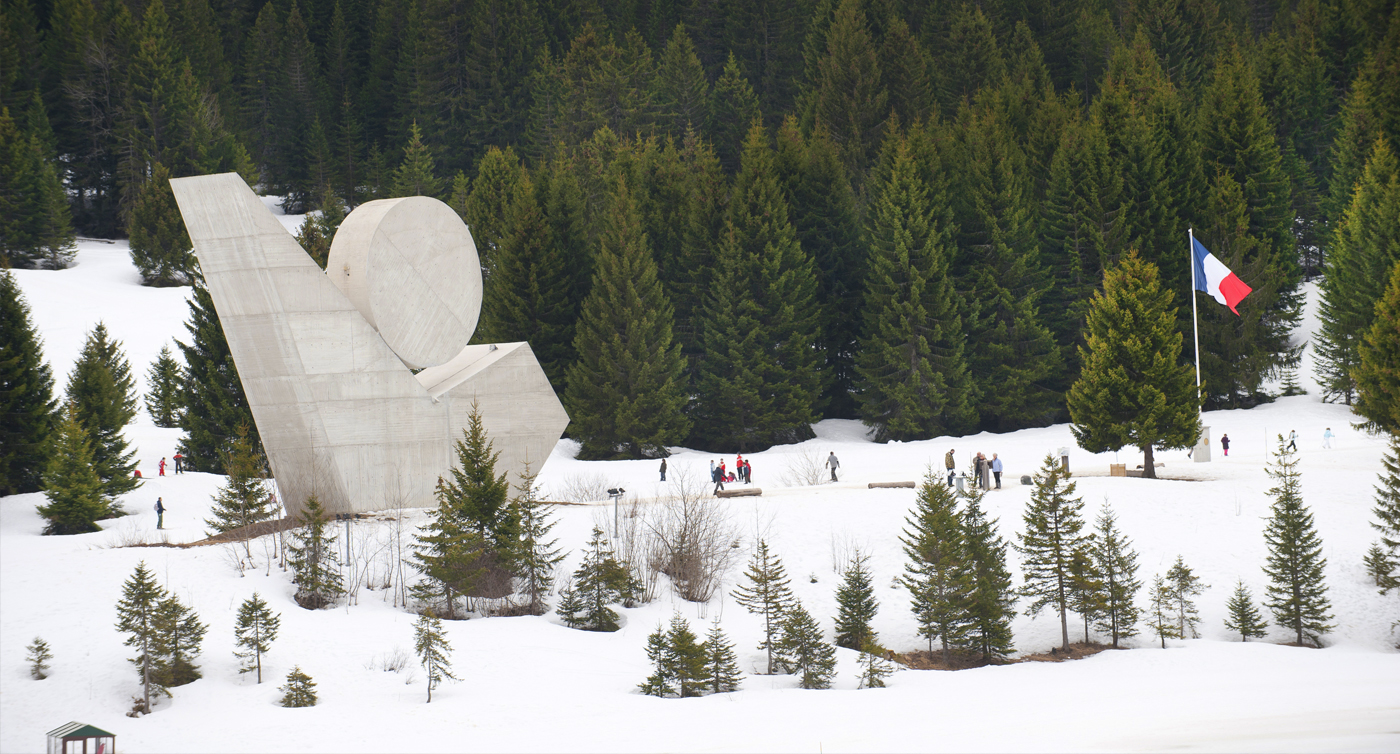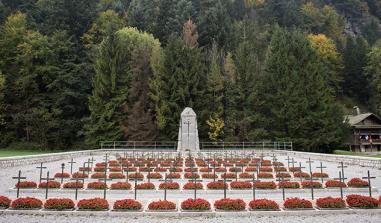National Monument to the Resistance Plateau Glières

Monument National de la Résistance. Source : Conseil Général de la Haute-Savoie
This memorial is a reminder of the theatre of battles between resistance fighters (maquisards), the French Militia and the German army between February and March 1944.
The Plateau des Glières and the Gilioli Monument A magnificent plateau situated at the heart of the Haute Savoie at an altitude of 1440m, the site of les Glières is not to be missed. An important place for the Résistance movement during the Second World War, its mountainous and therefore strategic territory made the Plateau des Glières an ideal place for parachuting in weapons for the local resistance movement. On the 31st January 1944, because of the "insurrectionary" situation, on the orders of the German authorities the collaborating Vichy government decided to bring the Resistance movement to an end and imposed a state of siege on the département. The same day, 120 maquisards under the orders of Lieutenant Tom Morel, head of the resistance fighters of the Secret Army in the Haute Savoie, climbed up to the Plateau des Glières to receive some parachute drops. The maquisards were former officers of the 27th Battalion of Alpine Chasseurs of Annecy, Spanish Republicans and Francs-Tireurs et Partisans(Partisan irregular riflemen) united by the same desire to liberate France. On the 26th March 1944, a large scale attack involving around 10,000 men was carried out by German troops and the French militia. The numbers involved were disproportionate to the 465 maquisards on the Plateau. After carrying out reconnaissance missions, the maquisards received the order from Captain Maurice Anjot, now in charge of the underground movement (maquis) following the death of Tom Morel, to retreat in the evening. 129 maquisards and 20 resistance fighters from the valleys, who had been unable to escape being surrounded by the forces carrying out the order, were killed during the fighting or were shot by firing squad or died during their deportation. From the start, the Battle of les Glières was the symbol of the French Resistance movement, thanks to radio broadcasts from London. In the months that followed, the maquis restructured in order to arrange a new parachute drop, which would take place on the 1st August. This allowed the liberation of the Haute-Savoie on the 19th August 1944, before the allied troops even arrived. On the 2nd September 1973 Emile Gilioli's National Monument to the Resistance, built on the initiative of the Survivors of les Glières, was inaugurated by André Malraux. It is not a monument to the dead, but rather a symbol of hope. Today there is a sign-posted circuit accessible for all levels of walkers along the parachute drop areas, guiding visitors along the Plateau des Glières which is now very much a part of the collective memory. The information boards along the walk tell of the daily life of the maquisards and the events of February and March 1944.
Footpaths of Remembrance On the plateau, there are footpaths to help you learn about the site of the parachute drops and the how the defence of the plateau was organised: The "Tom Morel" footpath, the only way of accessing the plateau in winter, was the route taken by supplies for the maquis. The footpath of "The Attack", which is relatively difficult due to its unevenness, was used by liaison agents of the Maquis of Les Glières. The Germans also took it during the attack of the 26th March 1944 at Monthièvret. The "Skirmish or "Black Water" footpath, which owes its name to the stream that comes from the Ablon valley and runs across blackish detrital rocks, was taken mainly by resistance fighters from Thorens. This is where the Militia lost heir first man. The footpath of the "Final Assault" allows access to the alpine pasture land of Champ-Laitier, which was attacked on the 16th March 1944. The "Spanish" footpath was the crossing point of a group of Spaniards from Nâves-Parmelan, as well as three Italians. Before them, the forest ranger of the sector had taken this path to accompany young draft dodgers to the Compulsory Work Service on the Plateau des Glières. A lookout post established on the Pas du Roc by the resistant fighters effectively sealed this crossing point. No attacker dared try his luck there. The footpath of "the Ultimatum" was a royal access route to the Plateau des Glières. It was secured down in the valley by the Vichy forces and up on the plateau by the maquisards. Two days before the German assault, it was taken by a group delivering the ultimatum for surrender. The Site of Morette
Located at the gateway to the Thônes valleys, the historic departmental site of Morette is composed of three major places: the National Necropolis of Les Glières the Departmental Museum of the Resistance the Departmental Memorial of the Deportation The National Necropolis of Les Glières The bodies of 105 resistance fighters, mainly soldiers from Les Glières, killed by the Germans and French forces of law and order rest in the Necropolis. The Departmental Museum of the Resistance is located in a high mountain chalet dating back to 1794 and representative of those that housed the maquisards. Created in 1964 by the Association of Survivors of les Glières, the original idea was to house all the souvenirs and documentation held by the Survivors in the museum. It became a departmental museum in 1978. It has displays on 3 levels offering an opportunity to follow the successive periods of the worldwide conflict, from 1939 up to the liberation of the Haute-Savoie in August 1944. The Departmental Memorial of the Deportation provides a deeply moving insight into the Nazi camps (photographs, maps of the Nazi camps, poetry by the deportees and uniforms etc.) Created in 1965 by the Association of Deportees, Internees and Families of the Haute-Savoie and associated with the National Union of Associations of Deportees, Internees and Families (l'Union Nationale des Associations de Déportés, Internés et Familles or UNADIF), it has now become a departmental Memorial. The current building houses an intentionally low key exhibition that claims to bear a message of remembrance and vigilance.
Site de Morette 74230 La Balme de Thuy Tel: +33 (0) 4 50 32 18 38 Memory of the Maquis Tel: 04 50 33 21 31 Opening hours of departmental websites Every day except Saturday from 9:30 to 12:30 and 13:30 to 17H In July and August, 7 / 7 days from 10am to 12.30pm and from 14H to 18H Morette site: closed in December and January Plateau Glières: closed from 1 October to 1st Saturday of the Christmas holidays included Information and reservations Guided tours can be arranged throughout the year, during the opening hours, by reservation. Educational activities on reservation.
Conseil Général de la Haute-Savoie Direction des Affaires Culturelles Service Mémoire et Citoyenneté 18, avenue du Trésum 74000 Annecy Tel: +33 (0) 4 50 51 87 00 Fax: +33 (0) 4 50 51 86 98 E-mail: resistancedepartementale74@cg74.fr

The Departmental Museum of the Resistance. Source: Haute-Savoie Regional Council

The Departmental Museum of the Resistance.
Practical information
site de Morette 74230
Thônes
Site de Morette 04 50 32 18 38 Plateau des Glières 04 50 33 21 31
Free admission
Every day except Saturdays, 9.30 am to 12.30 and 1.30 pm to 5 pm July and August, 7 days a week, 10 am to 12.30 pm and 2 pm to 6 pm
Morette Site: closed in December and January Glières Plateau: closed from 1 October to the 1st Saturday of the Christmas holidays



